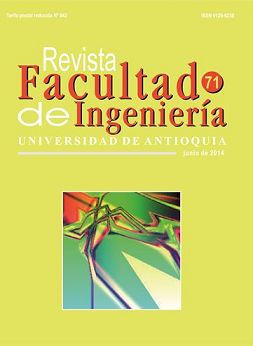Modelling of breakthrough curve in water adsorption on silica gel and zeolite 4A
DOI:
https://doi.org/10.17533/udea.redin.15316Keywords:
simulation, adsorption isotherm, breakthrough curve, adsorbents, fixed bed, water adsorptionAbstract
This paper presents the development of a computational model to simulate the adsorption of water in a fixed bed, comparing the performance of zeolite 4A and silica gel type ‘A’. A variation of the Langmuir isotherm for zeolite 4A and Tóth isotherm for the silica gel were used; Linear Driving Force (LDF) model was used for adsorption rate with an overall coefficient temperature dependent. The model is composed of five partial differential equations associated with mole fraction of water, temperature, pressure, superficial velocity and water loading. Method of lines (MOL) was used with the function ODE15S of Matlab® to solve the system. As response variables the characteristic time interval of the breakthrough curve, asymmetry, maximum temperature and pressure drop, through a two-level factorial scheme were evaluated. Adsorbent was the most influential variable on the response variables. Zeolite has the highest rate of adsorption due to the shape of the adsorption isotherm, but has a lower water retention loading and increased resistance to mass transfer.
Downloads
References
M. Simo, C. Brown, V. Hlavacek. “Simulation of Presure Swing Adsorption in Fuel Ethanol Production Process”. Comput. Chem. Eng. Vol. 32. 2008. pp. 1635-1649. DOI: https://doi.org/10.1016/j.compchemeng.2007.07.011
D. Ruthven. Principles of Adsorption and Adsorption Processes. 1st ed. Ed. John Wiley & Sons, Inc. New York, USA. 1984. pp. 1-433.
D. Ruthven, S. Farooq, K. Knaebel. Pressure Swing Adsorption. 1st ed. Ed. VCH Publishers, Inc. New York, USA. 1994. pp. 1-352.
M. LeVan, G. Carta, C. Yon. “Adsorption and Ion Exchange”. R. Perry, D. Green. (editors). Perry’s Chemical Engineers’ Handbook. 7a ed. Ed. McGraw-Hill. New York, USA. 1997. pp. 1-66.
A. Ribeiro, T. Sauer, C. Grande, R. Moreira, J. Loureiro, A. Rodrigues. “Adsorption Equilibrium and Kinetics of Water Vapor on Different Adsorbents”. Ind. Eng. Chem. Res. Vol. 47. 2008. pp. 7019-7026. DOI: https://doi.org/10.1021/ie701732x
X. Wang, H. Chua. “Two Bed Silica Gel –Water adsorption chillers: An effectual lumped parameter model”. Int. J. Refrigeration. Vol. 30. 2007. pp. 1417-1426. DOI: https://doi.org/10.1016/j.ijrefrig.2007.03.010
A. Gorbach, M. Stegmaier, G. Eigenberger. “Measurement and Modeling of Water Vapor Adsorption on Zeolite 4A-Equilibria and Kinetics”. Adsorption. Vol. 10. 2004. pp. 29-46. DOI: https://doi.org/10.1023/B:ADSO.0000024033.60103.ff
M. Gholami, M. Talaie. “Investigation of Simplifying Assumptions in Mathematical Modeling of Natural Gas Dehydration Using Adsorption Process and Introduction of a New Accurate LDF Model”. Ind. Eng. Chem. Res. Vol. 49. 2010. pp. 838-846. DOI: https://doi.org/10.1021/ie901183q
X. Wang, W. Zimmermann, K. Ng, A. Charraboty, J. Keller. “Investigation on the isotherm of silica gel+water systems TG and volumetric methods”. J. Therm. Anal. Calorim. Vol. 76. 2004. pp. 659-669. DOI: https://doi.org/10.1023/B:JTAN.0000028045.96239.7e
I. Park, K. Knaebel. “Adsorption breakthrough behavior: Unusual effects and possible causes”. AIChE J. Vol. 38. 1992. pp. 660-670. DOI: https://doi.org/10.1002/aic.690380504
M. Simo, S. Sivashanmugam, C. Brown, V. Hlavacek. “Adsorption/Desorption of Water and Ethanol on 3A Zeolite in Near-Adiabatic Fixed Bed”. Ind. Eng. Chem. Res. Vol. 48. 2009. pp. 9247-9260. DOI: https://doi.org/10.1021/ie900446v
R. Yang. Adsorbents: Fundamentals and applications. 1st ed. Ed. John Wiley & Sons, Inc. New Jersey, USA. 2003. pp. 1-410.
J. Seader, J. Siirola, S. Barnicki. “Distillation”.
R. Perry, D. Green. (editores). Perry’s Chemical Engineers’ Handbook. 7a ed. Ed. McGraw-Hill. New York, USA. 1997. pp. 1 108.
S. Sircar, J. Hufton. “Why Does the Linear Driving Force Model for Adsorption Kinetics Work?”. Adsorption. Vol. 6. 2000. pp. 137-147. DOI: https://doi.org/10.1023/A:1008965317983
D. Lide. CRC Handbook of Chemistry and Physics. 90a ed. Ed. CRC Press/Taylor and Francis. Boca Raton, USA. 2010. Version CD-ROM.
Y. Liu, J. Delgado, J. Ritter. “Comparison of Finite Difference Techniques for Simulating Pressure Swing Adsorption”. Adsorption. Vol. 4. 1998. pp. 337-344. DOI: https://doi.org/10.1023/A:1008898019954
W. Schiesser. The numerical Method of Lines. 1st ed. Ed. Academic Press. San Diego, USA. 1991. pp. 1-326.
M. Gwadera, K. Kupiec, J. Rakoczy. “Investigation of Thermal Effects of Water Vapor Adsorption on Zeolites”. Technical transactions: Mechanics. Vol.109. 2012. pp. 87-94.
Downloads
Published
How to Cite
Issue
Section
License
Copyright (c) 2018 Revista Facultad de Ingeniería

This work is licensed under a Creative Commons Attribution-NonCommercial-ShareAlike 4.0 International License.
Revista Facultad de Ingeniería, Universidad de Antioquia is licensed under the Creative Commons Attribution BY-NC-SA 4.0 license. https://creativecommons.org/licenses/by-nc-sa/4.0/deed.en
You are free to:
Share — copy and redistribute the material in any medium or format
Adapt — remix, transform, and build upon the material
Under the following terms:
Attribution — You must give appropriate credit, provide a link to the license, and indicate if changes were made. You may do so in any reasonable manner, but not in any way that suggests the licensor endorses you or your use.
NonCommercial — You may not use the material for commercial purposes.
ShareAlike — If you remix, transform, or build upon the material, you must distribute your contributions under the same license as the original.
The material published in the journal can be distributed, copied and exhibited by third parties if the respective credits are given to the journal. No commercial benefit can be obtained and derivative works must be under the same license terms as the original work.










 Twitter
Twitter